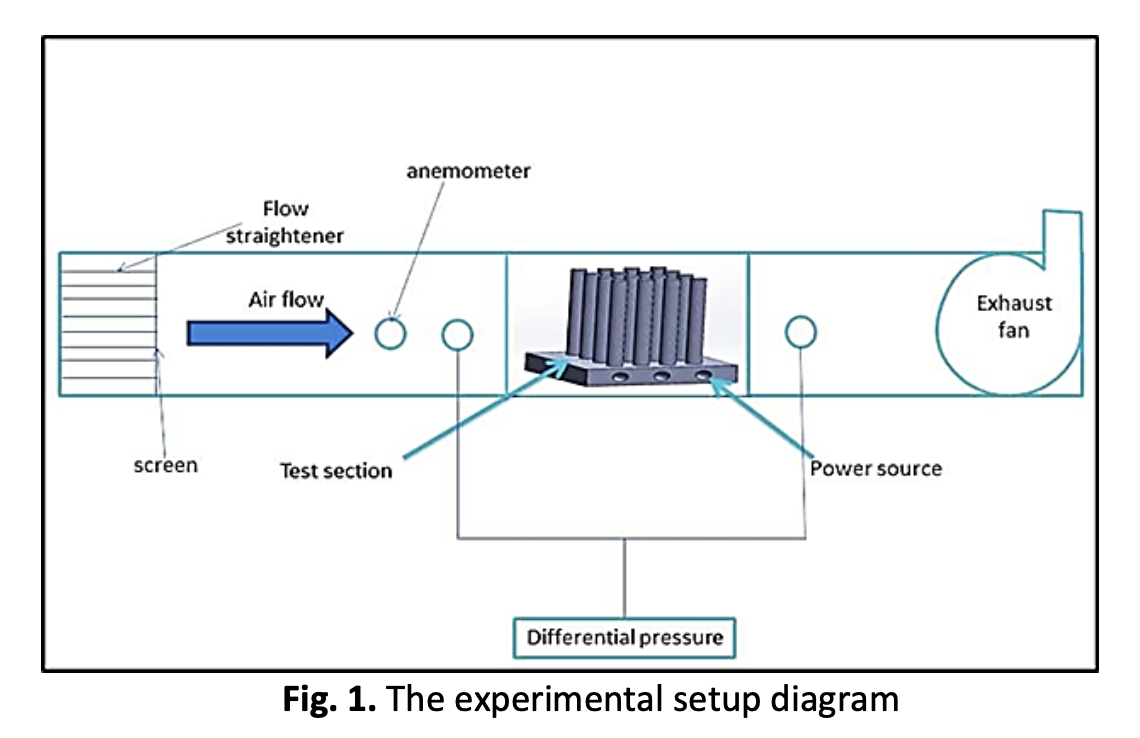Experiments and Numerical Investigations for Heat Transfer from a Horizontal Plate via Forced Convection Using Pin Fins with Different Hole Numbers
DOI:
https://doi.org/10.37934/cfdl.14.9.114Keywords:
Enhancement heat transfer, Forced Convection, Pin Fins, Hole NumbersAbstract
This study focuses on perforated pin fin convection heat transfer. This study's goal is to see if perforated pin fins may help transmit heat. Perforation diameter and hole count are evaluated on each pin. The Nusselt number of perforated pins is 47% higher than solid pins, and it increases with perforation count. Unperforated solid pins have a 19% lower pressure drop. Using pin fins with circular holes as heat sinks, we examined forced convection heat transfer. There were circular perforations. They were conducted in a specifically designed laboratory. At low power, non-perforated fins lose 35 to 31 degrees Celsius, while perforated fins lose only 29.8 degrees (50 W). At 55°C, unperforated fins hit 55°C at full power, while perforated fins hit 38°C (600 W). The model had 16 pin fins and was built of aluminum alloy. When compared to solid pin fins, perforated fins were found to be the best way to improve heat transfer because they were 40% lighter and improved thermal efficiency by 30% to 85% by increasing the Nusselt number and the convective heat transfer coefficient and reducing the pressure gradient.
Downloads
References
W. Al-Doori, “Enhancement of natural convection heat transfer from the rectangular fins by circular perforations,” Int. J. Automot. Mech. Eng., vol. 4, pp. 428–436, 2011. https://doi.org/10.15282/ijame.4.2011.5.0035
T. K. Ibrahim, A. T. Al-Sammarraie, M. S. M. Al-Jethelah, W. H. Al-Doori, M. R. Salimpour, and H. Tao, “The impact of square shape perforations on the enhanced heat transfer from fins: Experimental and numerical study,” Int. J. Therm. Sci., vol. 149, p. 106144, 2020. https://doi.org/10.1016/j.ijthermalsci.2019.106144
W. H. A. R. Al Taha, “Analysis, Performance and Optimization of Perforated and Non-Perforated Fins under Forced Convection.” Sudan University of Science and Technology, 2018.
W. H. A. Al Doori, “Effect of Using Various Longitudinal Fin Number In Finned Channel Heat Exchangers On Heat Flow Characteristics,” J. Adv. Res. Fluid Mech. Therm. Sci., vol. 53, no. 1, pp. 1–10, 2019.
T. K. Ibrahim et al., “Experimental and numerical investigation of heat transfer augmentation in heat sinks using perforation technique,” Appl. Therm. Eng., vol. 160, p. 113974, 2019. https://doi.org/10.1016/j.applthermaleng.2019.113974
S. Prakash and D. Chethan, “Experimental Investigation of the Heat Transfer Rate in Perforated Fins,” Int. J. Mech. Ind. Technol., vol. 3, no. 2, pp. 68–72, 2016.
M. Ehteshum, M. Ali, M. Q. Islam, and M. Tabassum, “Thermal and hydraulic performance analysis of rectangular fin arrays with perforation size and number,” Procedia Eng., vol. 105, pp. 184–191, 2015. https://doi.org/10.1016/j.proeng.2015.05.054
V. S. Choure, M. R. Jagadale, and V. W. Bhatkar, “Heat Transfer Enhancement using Perforated Pin Fins,” Int. J. Technol. Res. Eng., vol. 3, no. 2, pp. 2347–4718, 2015.
T.-M. Jeng, S.-C. Tzeng, and C.-H. Liu, “The effect of a piezoelectric fan on forced air heat transfer in a pin-fin heat sink,” Smart Sci., vol. 3, no. 1, pp. 1–6, 2015. https://doi.org/10.1080/23080477.2015.11665629
K. H. Dhanawade, V. K. Sunnapwar, and H. S. Dhanawade, “Thermal analysis of square and circular perforated fin arrays by forced convection,” Int. J. Curr. Eng. Technol., vol. 2, pp. 109–114, 2014. https://doi.org/10.14741/ijcet/spl.2.2014.20
W. H. Al Doori, “Numerical estimation of pressure drop and heat transfer characteristics in annular-finned channel heat exchangers with different channel configurations,” Heat Transf. Res., vol. 48, no. 4, pp. 1280–1291, 2019. https://doi.org/10.1002/htj.21432
U. V Awasarmol and A. T. Pise, “An experimental investigation of natural convection heat transfer enhancement from perforated rectangular fins array at different inclinations,” Exp. Therm. Fluid Sci., vol. 68, pp. 145–154, 2015. https://doi.org/10.1016/j.expthermflusci.2015.04.008
M. S. D. Bahadure and M. G. D. Gosavi, “Enhancement of natural convection heat transfer from perforated fin,”. Int. J. Eng. Res., vol. 3, no. 9, pp. 531–535, 2014. https://doi.org/10.17950/ijer/v3s9/903
H.-H. Wu, Y.-Y. Hsiao, H.-S. Huang, P.-H. Tang, and S.-L. Chen, “A practical plate-fin heat sink model,” Appl. Therm. Eng., vol. 31, no. 5, pp. 984–992, 2011. https://doi.org/10.1016/j.applthermaleng.2010.10.014
O. N. Şara, T. Pekdemir, S. Yapici, and H. Erşahan, “Thermal performance analysis for solid and perforated blocks attached on a flat surface in duct flow,” Energy Convers. Manag., vol. 41, no. 10, pp. 1019–1028, 2000. https://doi.org/10.1016/S0196-8904(99)00163-6
X. Yu, J. Feng, Q. Feng, and Q. Wang, “Development of a plate-pin fin heat sink and its performance comparisons with a plate fin heat sink,” Appl. Therm. Eng., vol. 25, no. 2–3, pp. 173–182, 2005. https://doi.org/10.1016/j.applthermaleng.2004.06.016
W. H. Aldoori, A. H. Ahmed, and A. M. Ahmed, “Performance investigation of a solar water distiller integrated with a parabolic collector using fuzzy technique,” Heat Transf. Res., vol. 49, no. 1, pp. 120–134, 2020. https://doi.org/10.1002/htj.21602
A. Yousfi, D. Sahel, and M. Mellal, “Effects of a pyramidal pin fins on CPU heat sink performances,” J. Adv. Res. Fluid Mech. Therm. Sci., vol. 63, no. 2, pp. 260–273, 2019.
A. M. A. Elfaghi, A. A. Abosbaia, M. F. A. Alkbir, and A. A. B. Omran, “CFD Simulation of Forced Convection Heat Transfer Enhancement in Pipe Using Al2O3/Water Nanofluid,” J. Adv. Res. Numer. Heat Transf., vol. 8, no. 1, pp. 44–49, 2022.
A. A. Khan, K. Zaimi, S. F. Sufahani, and M. Ferdows, “MHD Flow and Heat Transfer of Double Stratified Micropolar Fluid over a Vertical Permeable Shrinking/Stretching Sheet with Chemical Reaction and Heat Source,”. J. Adv. Res. Appl. Sci. Eng. Technol., vol. 21, no. 1, pp. 1–14, 2020. https://doi.org/10.37934/araset.21.1.114
S. V Patankar, Numerical heat transfer and fluid flow. CRC press, 2018. https://doi.org/10.1201/9781482234213
P. A. Deshmukh and R. M. Warkhedkar, “Thermal performance of elliptical pin fin heat sink under combined natural and forced convection,” Exp. Therm. Fluid Sci., vol. 50, pp. 61–68, 2013. https://doi.org/10.1016/j.expthermflusci.2013.05.005
Y. Peles, A. Koşar, C. Mishra, C.-J. Kuo, and B. Schneider, “Forced convective heat transfer across a pin fin micro heat sink,” Int. J. Heat Mass Transf., vol. 48, no. 17, pp. 3615–3627, 2005. https://doi.org/10.1016/j.ijheatmasstransfer.2005.03.017



























